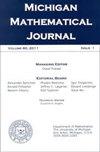Multiplicity Along Points of a Radicial Covering of a Regular Variety
IF 0.6
3区 数学
Q2 MATHEMATICS
引用次数: 0
Abstract
We study the maximal multiplicity locus of a variety X over a field of characteristic p > 0 that is provided with a finite surjective radicial morphism δ : X → V , where V is regular, for example, when X ⊂ A is a hypersurface defined by an equation of the form T −f(x1, . . . , xn) = 0 and δ is the projection onto V := Spec(k[x1, . . . , xn]). The multiplicity along points of X is bounded by the degree, say d, of the field extension K(V ) ⊂ K(X). We denote by Fd(X) ⊂ X the set of points of multiplicity d. Our guiding line is the search for invariants of singularities x ∈ Fd(X) with a good behavior property under blowups X → X along regular centers included in Fd(X), which we call invariants with the pointwise inequality property. A finite radicial morphism δ : X → V as above will be expressed in terms of an O V -submodule M ⊆ OV . A blowup X → X along a regular equimultiple center included in Fd(X) induces a blowup V ′ → V along a regular center and a finite morphism δ : X → V . A notion of transform of the O V -module M ⊂ OV to an O V ′ -module M ′ ⊂ OV ′ will be defined in such a way that δ ′ : X → V ′ is the radicial morphism defined by M . Our search for invariants relies on techniques involving differential operators on regular varieties and also on logarithmic differential operators. Indeed, the different invariants we introduce and the stratification they define will be expressed in terms of ideals obtained by evaluating differential operators of V on O V -submodules M ⊂ OV .沿正则变种的根覆盖点的多重性
我们研究了特征p > 0的域上变种X的最大多重轨迹,该域具有有限满射根态射δ: X→V,其中V是正则的,例如,当X∧a是由T−f(x1,…)方程定义的超曲面。, xn) = 0, δ是在V上的投影:= Spec(k[x1,…]xn))。沿X点的多重性以场扩展K(V)∧K(X)的度d为界。我们用Fd(X)∧X表示具有多重性d的点的集合。我们的指导方针是沿着Fd(X)中包含的正则中心寻找奇异点X∈Fd(X)在膨胀点X→X下具有良好行为性质的不变量,我们称之为具有点向不等式性质的不变量。上述有限根态射δ: X→V用OV -子模M∈OV表示。沿Fd(X)中包含的正则等重中心的放大X→X引起沿规则中心的放大V '→V和有限态射δ: X→V。OV -模M∧OV到OV ' -模M´∧OV '的变换的概念将被定义为δ ': X→V '是M定义的根态射。我们对不变量的搜索依赖于涉及正则变量的微分算子和对数微分算子的技术。实际上,我们引入的不同不变量及其定义的分层将用V在OV -子模块M∧OV上的微分算子的求值所得到的理想来表示。
本文章由计算机程序翻译,如有差异,请以英文原文为准。
求助全文
约1分钟内获得全文
求助全文
来源期刊
CiteScore
1.20
自引率
11.10%
发文量
50
审稿时长
>12 weeks
期刊介绍:
The Michigan Mathematical Journal is available electronically through the Project Euclid web site. The electronic version is available free to all paid subscribers. The Journal must receive from institutional subscribers a list of Internet Protocol Addresses in order for members of their institutions to have access to the online version of the Journal.

 求助内容:
求助内容: 应助结果提醒方式:
应助结果提醒方式:


